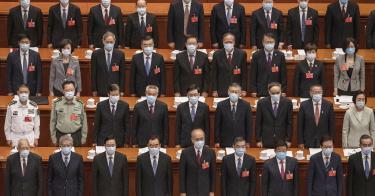The Chinese Communist Party’s leadership will meet this week to formalize its plans for the next five years (2021-2025). This will be the 14th “five-year plan” created by the Communist Party Congress, and is likely be adopted early next year. These five year plans play a central role in Chinese economic and broader policy planning, as they provide resources and policy direction across the Chinese bureaucracy for the next half decade.
Like previous plans, the 14th five-year plan will draw criticism from world leaders and continue to drive a wedge between Washington and Beijing.
China’s five-year plans provide observers with a sense of priorities and focus for key strategic missions. For example, Chinese military developments ranging from modernization goals to doctrinal shifts tend to occur within the framework of the five-year plan. Chinese military commenters have said that the “initial phase” of Chinese military reform will be completed by 2020, therefore, we would expect a new set of reforms and shifts to occur in the 2021-2025 timeframe.
Similarly, China’s space program tends to set its goals in the context of five-year plans. If China intends to go to the moon, it will have to fulfill key prerequisites in this upcoming half-decade.
China’s five-year plans always include a heavy focus on economic policies. Previous plans include economic growth targets (like gross domestic product), targets for employment and investment, and even industrial policies. The 13th five-year plan included the controversial “Made in China 2025” strategy, which seeks to make China the leader in ten strategic industries by 2025, and is one of many causes of conflict between Washington and Beijing.
This upcoming five-year plan is expected to be no less controversial economically. China’s President Xi Jinping is increasingly pushing for private companies to conform to Chinese communist ideology. Multiple crises have shown China’s economic weaknesses. And tensions are growing with its largest trading partners, particularly the U.S.
The biggest policy initiative likely to come from China’s 14th five-year plan is the formal announcement of a “dual-circulation” strategy. This strategy would essentially push for China to end its dependence on foreign products by increasing both domestic production and consumption.
A strategy that essentially cuts American products out of China’s market while also potentially increasing Chinese exports globally won’t be welcome in Washington (or in other countries for that matter).
The idea of ending dependence on foreign goods isn’t new in China, however. Reducing the market share of foreign semiconductors in China’s domestic market was included in the “Made in China 2025” strategy, for example. And Chinese leaders have proclaimed the need for self-reliance since the founding of the Chinese Communist Party over 70 years ago.
Even then, the last 20 years of China becoming a destination for foreign trade and investment shows the rhetoric of self-reliance may not be in China’s economic interests.
Dual-circulation falls in-line with a few of Beijing’s existing priorities. One priority is transforming China’s economy into one similar to the U.S. which bases much of its economic growth on a strong consumer base.
Another priority is supporting China’s long-term goal of “civil-military fusion,” where the civilian and military industrial bases are closely intertwined and cross-fertilizing. Advances on one side of the ledger would automatically accrue benefits for the other. It is likely that “dual-circulation” would also be touted within China as reducing Chinese vulnerability to foreign pressure. That it would also expand and increase the sophistication of the Chinese military would also mean it could help coerce both the U.S. and China’s neighbors.
Another priority for Beijing is its recent “China Standards 2035” strategy, which seeks to have China lead the standardization of technologies, particularly emerging technology. Everything from cables, to computers, to robots, to networks, and so on are built and operated to various standards—which are usually established by industry.
China’s problem, which often turns into a problem for Washington, is Beijing’s consistent double-standards. China wants to be taken seriously on the world stage as a major power, yet expects to be treated in environmental and trade terms as a “developing country,” subject to far more lax standards and requirements.
But the five-year plan will still likely include the tradition of trying to lay out targets for China’s economic growth, such as a specific GDP growth rate or level of exports. One of China’s economic “miracles” has been Beijing’s ability to “predict” China’s annual growth rate. In reality, growth rates set by Beijing occasionally lead to officials inflating growth statistics in order to report success and undermining the accuracy of reported statistics.
This year has been unique so far in that Beijing has abandoned setting a growth rate for this year given the effect the pandemic has had on China’s economy. Reported GDP fell by 6.8% and grew only by 3.2% in the first two quarters (or first half) of 2020. China reported 4.9% growth year over year in the third quarter as well but while there is little doubt the Chinese economy is in recovery, there’s heavy skepticism that it is quite so robust.
The fact of the matter is almost all of China’s recent gains are from investments (often government supported) and exports (i.e., American consumption). China’s consumer base isn’t exactly positioned to take a leading role in China’s economic growth model.
Other issues that could be included in China’s next five-year plan are ways to reinforce a recent export control law that China passed as a way to respond to American export control laws. And the five-year plan may include lip-service to China’s efforts to fight climate change—even though China is the world’s largest producer and consumer of coal.
China’s five-year plans, while not always accurate or practical, give China watchers a look at Beijing’s priorities for the next few years. This year’s plans are likely to be as controversial as ever.
This piece originally appeared in The Daily Signal



